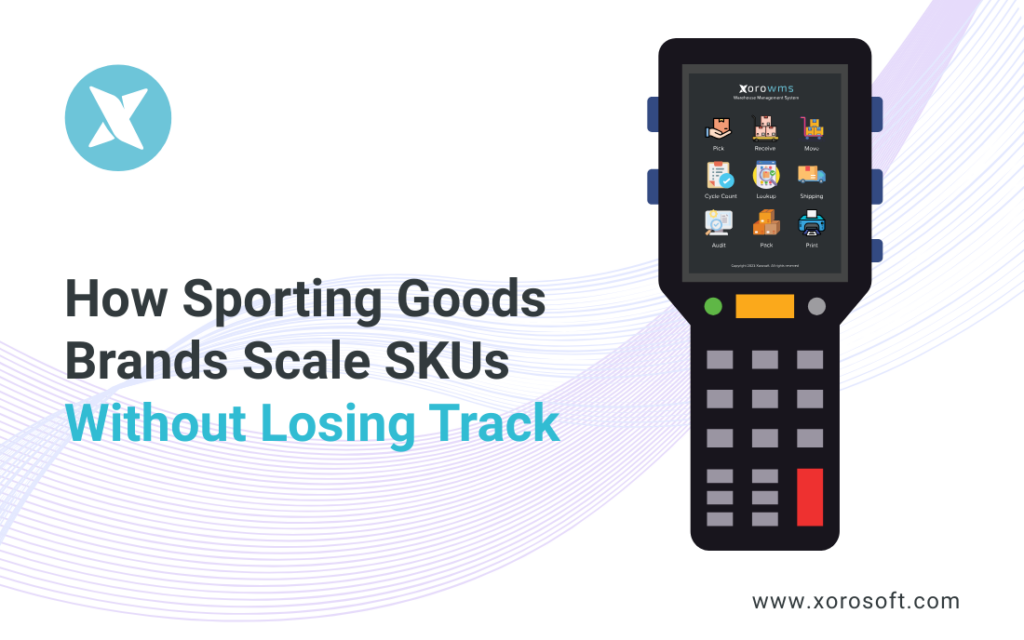
Why Scaling SKUs Creates Chaos in Sporting Goods
If you run a sporting goods brand, you know how quickly scaling SKUs gets out of control. One year, you manage a handful of shoes or jerseys. The next, you’re handling dozens of styles, sizes, colors, and special editions.
As a result, your once-manageable catalog grows into thousands of variants. Consequently, stockouts creep in, fulfillment slows down, and accounting errors multiply. Ultimately, growth feels overwhelming—not because demand disappears, but because operations can’t keep up.
The Hidden Costs of Disconnected Tools
Sporting goods live in one of the most SKU-intensive industries. For example, a single cleat with 12 sizes, 8 colors, and 3 materials creates hundreds of SKUs. In addition, when you add apparel, accessories, and seasonal collections, complexity skyrockets.
When brands rely on fragmented systems, here’s what happens:
-
Inventory records become unreliable, so staff fall back on spreadsheets.
-
Orders split across apps, and fulfillment slows as teams chase missing stock.
-
Duplicate entries appear, leaving finance departments untangling messy data.
Moreover, the pressure is not only financial. Teams burn out fighting daily fires. Customers lose patience with stockouts. Partners lose trust in the brand. Therefore, growth stalls—not from lack of opportunity, but from lack of control.
Why Scaling SKUs Spirals Out of Control
So, what actually drives this chaos? The root cause is fragmented systems. Many brands piece together spreadsheets, QuickBooks, an e-commerce backend, and a shipping app. At first, this seems workable. However, as SKUs multiply, cracks widen.
-
Without real-time visibility, planners make decisions on outdated exports.
-
With data scattered across channels, every new storefront or marketplace adds another island.
-
Without a built-in warehouse management system (WMS), fulfillment stays slow and error-prone.
In short, disconnected apps were never designed to manage SKU-heavy growth.
Unified ERP Turns Scaling SKUs Into an Advantage
The turning point comes when brands switch to a unified ERP platform instead of patching together tools. With ERP, scaling SKUs becomes manageable.
-
Real-time inventory accuracy. Every size, color, and warehouse location is visible instantly. Therefore, planners can act on live data.
-
Centralized fulfillment. Orders from Shopify, Amazon, or retail partners flow into one hub. Consequently, warehouse teams avoid delays and mistakes.
-
Integrated accounting. Sales, returns, and landed costs post automatically. As a result, finance closes faster and with fewer errors.
-
Cross-team visibility. Everyone from operations to finance sees the same truth. Moreover, collaboration improves because silos disappear.
Accordingly, SKU growth becomes an advantage, not a liability. Sporting goods brands can confidently expand into new categories, channels, and regions without losing control.
How Xorosoft ERP Simplifies SKU Management
This is where Xorosoft ERP delivers a clear edge. Unlike legacy tools, it is cloud-native, fast to deploy, and designed for real-time clarity. More importantly, it includes a robust built-in WMS, so warehouse teams gain precision without extra apps.
-
Powerful WMS. Picking, packing, and transfers are streamlined across multiple locations. Consequently, errors drop and orders ship faster.
-
Native integrations. Connect to Shopify, Amazon, EDI, and 3PLs seamlessly. As a result, every channel stays aligned.
-
Automation at scale. Reordering, POs, and reporting run automatically. Therefore, teams spend less time on manual entry and more on strategy.
-
Financial clarity. Integrated accounting ensures that as SKUs multiply, reports remain accurate. In other words, numbers stay trustworthy.
-
Ease of use. Xorosoft is ranked #1 in Ease of Use on G2 and recognized as a High Performer, so adoption is fast.
With Xorosoft, SKU growth is no longer a bottleneck. Instead, it becomes a competitive advantage.
Practical Steps for Getting Ahead of SKU Growth
To tame SKU complexity, start with these steps:
1. Unify item masters. Standardize attributes across channels to eliminate duplicates. Consequently, reporting improves immediately.
2. Set replenishment rules. Define min/max and lead times so buys happen on time. As a result, stockouts shrink while overstock drops.
3. Map warehouse flows. Label bin locations and optimize pick paths. Therefore, picking errors decline.
4. Automate repetitive tasks. Trigger POs, reorder alerts, and pick waves automatically. Moreover, teams save hours weekly.
5. Track performance. Monitor OTIF, pick accuracy, and days of supply. Consequently, leaders spot risks early and act faster.
Because each step builds on the previous, momentum compounds quickly once processes align.
Scaling SKUs Without Losing Track
Growth should not feel like chaos. With the right system, scaling SKUs becomes predictable. Inventory stays accurate, orders move faster, and financials stay clean.
Above all, sporting goods brands deserve systems that grow with them. Xorosoft ERP is built for speed, clarity, and automation. Therefore, your next product launch—or your next thousand SKUs—adds momentum, not stress.
👉 Explore XoroONE today or book a demo to see how sporting goods brands scale SKUs without losing track.









